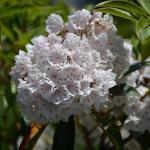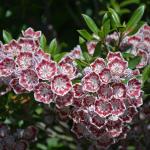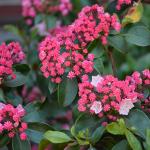A monthly e-newsletter from UMass Extension for landscapers, arborists, and other Green Industry professionals.
To read individual sections of the message, click on the section headings below to expand the content:
Hot Topics
New Insect Identification Online Resources Fact Sheet
Looking for resources to help identify an insect? Check out the new UMass Extension Insect Identification Online Resources Fact Sheet. Keep in mind that identifying an insect via only a photograph can be very difficult if not impossible and that misidentifications are possible. If you have a pest insect on an ornamental tree or shrub that you cannont identify, consider sending it to the UMass Plant Diagnostics Laboratory for identification.
Lily Leaf Beetle Project
The University of Rhode Island Biological Control Lab is researching ways to find a natural method to combat lily leaf beetle. Small parasitic insects have been established in lily plots in Cumberland, RI and Wellesley, MA in hopes that these insects will disperse naturally to reduce the effects of the lily leaf bUeetle.
In an attempt to track these parasitic insects, URI would like to collect the larvae found on your lilies (they can be identified as the brown blobs, since they cover themselves in their excrement). The larvae will be dissected to identify the parasitic insects.
If you have larvae in your yard (or customers), please send to URI, following the instructions on the URI Biocontrol Lab website.
Ticks are active at this time!
Remember to take precautions when working outdoors and to conduct daily tick checks. The UMass Amherst Laboratory of Medical Zoology tests ticks for Lyme Disease and other tick-borne pathogens. Visit the Tick Report website for more information.
Questions & Answers
Q: I manage a property than has a sizable patch of Japanese knotweed. The knotweed has sprouted and is currently 3 to 5 feet tall. Can I treat this population with glyphosate now?
A: Glyphosate products applied in the spring and early summer will not control Japanese knotweed. The best time to treat Japanese knotweed is in August when the plant is in flower. In preparation for this application, Japanese knotweed should be mowed or cut to the ground (late May thru very early June). This action will make it easier to treat by removing the dry stems from previous years and the knotweed will be shorter at time of treatment.
Q: I use Snapshot® for weed control in ornamental beds. Another landscaper suggested I try FreeHandTM as an alternative. Is this something I should consider?
A: Both products are used for the control of annual grass and broadleaf weeds. A large number of ornamental species are tolerant of Snapshot® and FreeHandTM. When applied in a landscape comprised of several different species review the FreeHandTM label for ornamental species that are tolerant. Do not assume that if Snapshot® has been used without injury to ornamentals that FreeHandTM will not cause injury. FreehandTM is a combination of dimethenamid and pendimethalin. Dimethenamid has preemergence activity on yellow nutsedge. A switch to FreeHandTM from Snapshot® should be considered if yellow nutsedge is a problem in the landscape. For more information on FreeHandTM and TowerTM, another dimethenamid containing product, visit: Misconceptions about superweeds and a tool for managing yellow nutsedge.
Q: Which herbicide products should have a surfactant added when applied? Can the same surfactant be used with all my herbicide applications??
A:Surfactants should only be added when required on the herbicide label. Different products will require different surfactants, so a single surfactant can’t be used for all products. The addition of a surfactant to an herbicide application that is not required by the label increases the risk of turf injury or death.
Randy Prostak,UMass Extension Weed Specialist
Trouble Maker of the Month
Stem Blight of Vinca
Stem blight of vinca is most active in just the kind of cool, wet weather we’ve had in Massachusetts this spring. The fungus Phoma exigua is the most commonly cited cause of stem blight, though it is sometimes referred to as Phomopsis and Phyllosticta. The fungus overwinters in infected leaf litter, and spores released in spring cause infection of new growth. The optimum temperature range for infection is 50-65°F (10-18°C), and stem lesions will become evident approximately 2 weeks after infection. Stem blight may also occur in the fall.
Wilting or dead shoots may be the first visible symptom of stem blight. Brown or black stem lesions will be observed on closer inspection, often around leaf nodes, and adjacent leaves may be brown and withered. Stems may be completely girdled and die back. Spores are produced within the lesions in tiny black fruiting bodies called pycnidia. These may be visible with a hand lens. Rhizoctonia causes similar symptoms in vinca, but it does not produce pycnidia. The infection cycle can continue as long as the weather is conducive.
Management: Plant diseases are easier to prevent than they are to control. Start with healthy plants, and use resistant cultivars if they are available. The cultivar ‘Darts Blue’ is reportedly resistant to stem blight. Other cultivars may also be tolerant or resistant. Vinca prefers partial to full shade and reasonably fertile, well-drained soil. Plants that are stressed by improper site conditions will be more susceptible to disease.
Remove dead and unhealthy plant material regularly. Phoma is an excellent saprophyte that survives in plant litter and thrives in moist conditions. Thinning plants will improve air circulation and promote drying of foliage after rain or irrigation. Avoid overhead watering if possible. Water early in the morning, as the sun will allow foliage to dry more quickly. Do not work with plants when they are wet.
An annual soil drench in late April or early May with thiophanate-methyl or copper sulfate may be useful to keep stem blight in check. In areas where infection is severe, consider replacing vinca with a different ground cover.
Angela Maderias, Plant Pathologist, UMass Extension Plant Diagnostic Lab
Plant of the Month
Kalmia latifolia, mountain laurel
Kalmia latifolia is a broadleaf evergreen shrub native to woods, mountain slopes, and woodland margins in eastern North America. Form can vary from dense and compact to open depending on light exposure. Size can range from 5-12’ tall and wide, and can grow larger especially in native habitats. Mountain laurel is cold hardy to zone 5 and protected areas of zone 4. Leaves are elliptical with smooth margins and pointed tips. The 2-5” long and 0.75-1.5” wide leaves are dark green, glossy, leathery and clustered towards shoot tips.
Flowers occur in early June (sometime late May). Individual flowers are small, cup shaped, and around 1”, but grow in 4-6” clusters at branch tips. The species has pink flowers that fade to almost white. Cultivars offer many variations including red or pink buds, red bands or dots, white, deep pink or red flowers. Flowers last several weeks and are very showy. It is best to remove spent flowers as the brown, dehiscent seed capsules are not showy and will persist into winter. Bark is lightly ridged and furrowed. As plants age trunks can become twisted and gnarly providing additional ornamental interest.
Mountain laurel should be planted in part sun to full sun, with part shade being best. It can be grown in deeper shade but will be more open and bloom less. A cool, moist, acidic, well-drained soil is best. Kalmia latifolia has a fine, fibrous, shallow root system which benefits from mulching. Pruning should be after bloom. Leaf spot can be a problem, especially in heavy shade, but some cultivars offer improved resistance. Lacebug can also be a problem. Leaf burn can be an issue in exposed sites. All parts of the plant are toxic if ingested.
The genus was named after Pehr Kalm who explored plants in eastern North America from 1747-1751. Kalmia latifolia is the state flower of Pennsylvania and Connecticut. Kalmia latifolia v. myrtifolia cultivars ‘Elf’, ‘Minuet’, Tiddlywinds’, ‘Tinkerbell’, and ‘Little Linda’ were the 2003 Cary Award Winners.
Kalmia latifolia v. myrtifolia – slower growth rate and smaller leaves. Many of the new dwarf cultivars are from this variety including ‘Elf’ and ‘Minuet’.
There are numerous cultivars offering dwarf habits and variations in flowers.
- ‘Bullseye’ – flowers have a purple band; upright growth habit to 4-5’; emerging foliage is reddish-bronze
- ‘Carousel’ – to 8’; pale pink buds open to white flowers with purple bands and blotches
- ‘Elf’ – semi-dwarf (2-3’); smaller leaves and slower growth; pink buds opening to white
- ‘Minuet’ – 2-3’, light pink buds open to white flowers with a maroon band
- ‘Ostbo Red’ – 4-6’; bright red buds open to light pink flowers
- ‘Raspberry Glow’ – 4-5’, red buds open to raspberry-pink flowers
- ‘Sarah’ – 4-5’, red buds open to pink-red to coral pink with red markings
Mandy Bayer, Extension Assistant Professor of Sustainable Landscape Horticulture, University of Massachusetts Amherst
Upcoming Events
Featured Event: Landscape Pests and Problems Walkabout - Insects, Weeds, and Cultural Problems
Get some hands-on experience scouting and identifying landscape insects, weeds, and abiotic problems. Join Randy Prostak, Extension Weed Specialist; Tawny Simisky, Extension Entomologist; and Geoffrey Njue, Extension Sustainable Landscapes Specialist, for a walk through the landscape as they discuss and demonstrate how to put IPM practices to work efficiently and examine some of the most common pest and cultural problems of woody ornamentals.
Event Location: Long Hill, Beverly, MA
Other Upcoming Events:
- 6/8: Weed Walkabout
- 6/15: Landscape Pests and Problems Walkabout - Insects, Weeds and Cultural Problems
- 6/22: Topics in Landscape IPM
- 7/26: UMass Turf Research Field Day
- 8/8-8/10: Bark Beetle Identification and Related Topics Trainings
- 11/29-12/1: New England Grows
For more information and registration for any of these events visit the UMass Extension Landscape, Nursery, and Urban Forestry Program Upcoming Events Page.
Additional Resources
For detailed reports on growing conditions and pest activity – Check out the Landscape Message
For commercial growers of greenhouse crops and flowers - Check out the New England Greenhouse Update website
For professional turf managers - Check out Turf Management Updates
For home gardeners and garden retailers - Check out home lawn and garden resources. UMass Extension also has a Twitter feed that provides timely, daily gardening tips, sunrise and sunset times to home gardeners, see https://twitter.com/UMassGardenClip
Diagnostic Services
A UMass Laboratory Diagnoses Landscape and Turf Problems - The UMass Extension Plant Diagnostic Lab is available to serve commercial landscape contractors, turf managers, arborists, nurseries and other green industry professionals. It provides woody plant and turf disease analysis, woody plant and turf insect identification, turfgrass identification, weed identification, and offers a report of pest management strategies that are research based, economically sound and environmentally appropriate for the situation. Accurate diagnosis for a turf or landscape problem can often eliminate or reduce the need for pesticide use. For sampling procedures, detailed submission instructions and a list of fees, see Plant Diagnostics Laboratory
Soil and Plant Nutrient Testing - The University of Massachusetts Soil and Plant Nutrient Testing Laboratory is located on the campus of The University of Massachusetts at Amherst. Testing services are available to all. The function of the Soil and Plant Nutrient Testing Laboratory is to provide test results and recommendations that lead to the wise and economical use of soils and soil amendments. For complete information, visit the UMass Soil and Plant Nutrient Testing Laboratory web site. Alternatively, call the lab at (413) 545-2311.




